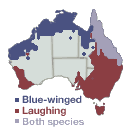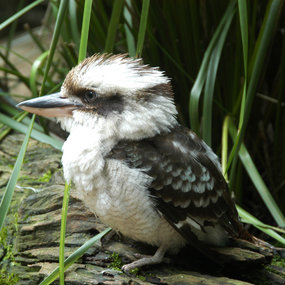By Rachel
Sullivan
Springtime is no laughing
matter for kookaburra chicks as they fight for survival in the family
nest.
The kookaburra's
familiar laugh is taking on a softer, more intimate note as the spring breeding
season gets into full swing. But their cheery call and rich family life also
hide a darker side: in a grim battle for resources hatchlings fight to the
death, watched over by their mother.
The largest members of the
kingfisher family, kookaburras are native to Australia and Papua New Guinea.
Australia is home to two of the four species: the colourful northern blue-winged
kookaburra (Dacelo leachii) which is found in the country's north, as
far south as Broome on the west coast and Brisbane on the east; and the iconic
laughing kookaburra (Dacelo novaeguineae), which is found all along the
east coast, from the Eyre Peninsula to Cape York.
"[Laughing] kookaburras were also
successfully introduced to Perth, Tasmania, Flinders and Kangaroo Islands," says
Dr Sarah Legge, who studied laughing kookaburras for her PhD and is now the lead
ecologist with the Australian Wildlife Conservancy.
"They were also introduced to Fiji
at the start of the 20th century but the experiment was short-lived ? they had
all disappeared within 25 years. Attempts to introduce them to New Zealand were
slightly more successful, with small populations still found in the North
Island," says Legge.
The two species are easily
distinguished by their laugh and the colour of their eyes. The blue-winged
kookaburra has a maniacal screech compared to its much more jovial cousin, and
tends to have a staring, white eye while laughing kookaburras' eyes are brown
with a brown patch of feathers behind the eye.

Fact file
When:September to
January
Where: Northern
blue-winged kookaburras are found in the tropical north as far south as Broome
on the west coast and Brisbane on the east. Laughing kookaburras are found all
along the east coast, from the Eyre Peninsula to Cape York, as well as
introduced populations in Perth, Tasmania, Flinders and Kangaroo
Islands.
Other information:
Where their ranges overlap, blue-winged and laughing kookaburras compete
directly for food and other resources. Experts think that although they share a
common ancestor, the two species evolved in isolation, and came together only
recently ? in geological time anyway.
Family life
Although kookaburras require trees
with nest hollows or arboreal termite mounds for breeding, most of the year they
roost in family groups, snuggled up together on a branch.
"From the amount of noise they make
they appear to be everywhere, however the number of kookaburra families living
in an area depends on the productivity of their territory," says Legge.
"In a high productivity area like
Victoria's Dandenongs there is a group every 40 hectares; but around Canberra,
where the land is less productive, each group needs around 2000 ha of
territory."
Kookaburras eat a range of prey,
including small reptiles such as lizards and snakes, insects, worms, snails,
frogs, rodents and even the occasional small bird. "Because they are such big
birds, with large beaks, they are not very agile when flying so only rarely
catch prey on the wing," says Legge.
"Instead they focus on catching prey
moving through the leaf litter. They either watch from a branch or sit very
still on the ground, watching for telltale movement.
"Then they strike, and carry their
prey back up to the tree where they bash it against a branch to kill it, and
soften it before throwing back their head and swallowing." Indigestible bones
and hair are later regurgitated in pellet form.
Legge says that ranges may be
smaller in urban areas because clearing exposes leaf litter and gardens provide
lots of good habitat for invertebrates and small lizards, but they are limited
by the number of nest hollows available for breeding. "They can withstand some
modifications to their habitat, but are limited by this fundamental
need."

The bigger the better:
this fat little laughing kookaburra chick has a survival edge over its siblings
(Source: istockphoto)
Survival of the
fittest
Kookaburras mate for life and live
in close family groups, comprising two adults and the older siblings from
previous breeding seasons, which remain for up to three years to help their
parents incubate the eggs, and feed and protect the chicks and fledglings before
moving on to nests of their own.
'Kookaburras are unusual because
they exhibit two extremes of social behaviour ? as older birds they are
altruistic helping the parents to raise their siblings, but as chicks they
actively try to kill each other.
"From an evolutionary perspective
it's a silly thing to do," says Legge, "but it's a resource issue."
The mother lays three eggs, but
about 50 per cent of the time there isn't enough food available to raise all
three chicks, she says. "There is only a 10 per cent chance of hatching failure,
so if all three do hatch, it is best for the group that one hatchling is
disposed of before too much time or resources are invested in it ? usually it's
all over in the first three days."
Legge says that while the parents
allow the chicks to sort out between themselves which one is the feeblest, the
mother actually controls the siblicide through controlling the time between
hatchings.
"Hatching rates vary, which makes it
fairly easy to pick who the winners and losers will be in a battle between nest
mates. They can all hatch within a 24-hour period or up to 72 hours
apart.
"In addition, the third egg is
usually the smallest, and the first chick to hatch is male, the second female.
But females grow faster, which makes the dominance hierarchy unstable and leads
to more fighting."
If it's taking too long, the mother
will take drastic steps: she will brood the chicks, then step back and watch
them fight until they become torpid with cold, then start the process all over
again.
"It's hard for the mother to assess
which chicks are the strongest, but if she lets them fight it out the matter is
quickly resolved."
While it sounds unnecessarily cruel,
Legge says that if the family tried to raise three chicks they might all be
stunted, reducing their chance of survival anyway. "The goal is to produce big,
fat, healthy chicks."
Older siblings help their parents do
this by helping to brood the eggs, and feeding and protecting the nestlings.
"This reduces the workload for the parents, helping them to live longer and
produce more clutches of eggs," Legge comments. "It helps ensure the survival of
the young and also teaches the older siblings how to feed and raise their own
families, meaning that more genes will be represented in the next
generation."
Some helpers are more diligent than
others, however. "Daughters tend to arrive at the nest with food, and make a big
fuss over what they have found then quietly eat it themselves when no-one is
looking," Legge laughs. "They are bigger than the males and not as agile so it's
probably harder for them to find food" adding that it's also more energy
efficient to be small, so they need to eat more to keep going.
Laugh, kookaburra,
laugh
Most Australians are so familiar
with the kookaburras' raucous cacophony that we barely notice their dawn and
dusk calls.
"The point of the morning call is
not entirely clear," says Legge, "although it is likely to be a territorial
proclamation saying 'we're still here, we survived the night, don't mess with
us'." She adds that calling frequency increases when the nestlings
fledge.
While their loud laugh that can be
heard over long distances and is best known, kookaburras have a range of calls
that are used at different times.
The year-round laugh
song advertises territorial ownership, as does the
chuckle, which is also used to find missing family members.
Both species' laugh song is similar in the way family members join in at
different times - making the song seem to rise and fall - but the laugh song of
the blue-winged kookaburra sounds maniacal or insane compared with the more
jovial laughter of the laughing kookaburra.
The chuck is used
in breeding, and the squawk is used to beg for food or is a sign of submission
to aggressive family members, while the softer, more intimate
croon or soft squawk is used in courtship and
to calm the breeding female.
The cackle signals
aggression and an imminent attack, while the kooaa is used year
round as a warning to the group.
At last, we know
what the kookaburra is laughing about.
Source: http://www.abc.net.au/science/articles/2009/10/14/2712935.htm

